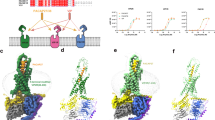Abstract
Receptors for the neurotransmitter and neuroendocrine peptides, vasoactive intesinal peptide (VIP) and secretin, both belong to the Type B subfamily of G-protein-coupled receptors. This group is evolutionally as well as structurally distinct from the much larger Type A, or rhodopsin-type, subfamily. We have mapped the ligand-activating epitopes of the human VIP1 receptor by the use of hybrid receptor constructs with the human secretin receptor. Twelve chimeras were synthesized by successively replacing portions of the former receptor with corresponding portions of the latter receptor, or by interchanging the first extracellular loops. Each of the different chimeric receptor DNAs were then expressed in murine reporter cells, and their ability to activate cAMP production was investigated on stimulation with the respective natural peptide ligands. We stimulated the reporter cells with secretin or VIP following transient expression of the receptor chimeras. The experiments indicated that there are two molecular domains of importance for the recognition and activation of these peptides, namely, the inner portion of the extracellular tail and the first extracellular loop of the two receptors.
Similar content being viewed by others
References
Arimura A. and Said S. S., eds. (1996) VIP, PACAP, and related peptides. Ann. NY Acad. Sci. 805, 1–792.
Beaubien B., Tippins J. R., and Morris H. R. (1984) Platelet-activating factor stimulation of peptidoleukotriene release: inhibition by vasoactive polypeptide. Biochem. Biophys. Res. Com. 125, 105–108.
Barik S. and Galinski M. S. (1991) “Megaprimer” method of PCR: increased template concentration improves yield. BioTechniques 10, 489,490.
Bolin D. R., Michalewsky J., Wasserman M. A., and O’Donnel M. (1995) Design and development of a vasoactive intestinal peptide analog as a novel therapeutic for bronchial asthma. Biopolymers 37, 57–66.
Buggy J. J., Livingston J. N., Rabin D., and Warren H. Y. (1995) Glucagon, glucagon-like peptide I receptor chimeras reveal domains that determine specificity of glucagon binding. J. Biol. Chem. 270, 7474–7478.
Gether U., Johansen T. E., and Schwartz T. W. (1993) Chimeric NK1 (substance P)/NK3 (neurokinin B) receptors. Identification of domains determining the binding specificity of tachykinin agonists. J. Biol. Chem. 268, 7893–7898.
Gourlet P., Vilardaga J.-P., De Neef P., Waelenbroeck M., Vandemeers A., and Robberecht P. (1996) The C-terminus ends of secretin and VIP interact with the N-terminal domains of their receptors. Peptides 17, 825–829.
Hjorth S. A., Adelhorst K., Pedersen Brogaard B., Kirk O., and Schwartz T. (1994) Glucagon and glucagon-like peptide 1: selective receptor recognition via distinct peptide epitopes. J. Biol. Chem. 269, 30,121–30,124.
Holtmann M. H., Hadac E. M., and Miller L. J. (1995) Critical contributions of amino-terminal extracellular domains in agonist binding and activation of secretin and vasoactive intestinal polypeptide receptors. Studies of chimeric receptors. J. Biol. Chem. 270, 14,394–14,398.
Horton R. M., Cai Z., Ho S. N., and Pease L. R. (1990) Gene splicing by overlap extension: tailor-made genes using the polymerase chain reaction. BioTechniques 8, 528–535.
König M., Mahan L. C., Marsh J. W., Fink J. S., and Brownstein M. J. (1991) Method for identifying ligands that bind to cloned Gs- or Gi - coupled receptors. Mol. Cell. Neurosci. 2, 331–337.
Lardelli M. and Lendahl U. (1994) Generating bacteriophage lambda sublibraries enriched for rare clones. BioTechniques 16, 420–422.
Lefebre B., Formstecher P., and Lefebre P. (1995) Improvement of the gene splicing overlap (SOE) method. BioTechniques 19, 186–188.
Ollerenshaw S., Jarvis D., Woolcock A., Sullivan C., and Scheibner T. (1989) Absence of immunoreactive intestinal polypeptide in tissue from the lungs of patients with asthma. New Engl. J. Med. 320, 1244–1248.
Patel D. P., Kong Y., and Sreedharan S. P. (1995) Molecular cloning and expression of a human secretin receptor. Mol. Pharm. 47, 467–473.
Pont-Kingdon G. (1994) Construction of chimeric molecules by a two-step recombinant PCR method. BioTechniques 16, 1010,1011.
Sarkar G. and Sommer S. S. (1990) The “megaprimer” method of site-directed mutagenesis. BioTechniques 8, 404–407.
Segre G. V. and Goldring S. R. (1993) Receptors for secretin, calcitonin, parathyroid hormone (PTH)/PTH-related peptide, vasoactive intestinal peptide, glucagonlike peptide 1, growth hormone-releasing hormone and glucagon belong to a newly discovered G-protein-linked receptor family. Trends Endocrinol. Metab. 4, 309–314.
Tams J., Knudsen S. M., and Fahrenkrug J. (1998) Proposed arrangement of the seven transmembrane helices in the secretin receptor family. Rec. Channels 5, 79–90.
Trotz M. E. and Said S. L. (1993) Vasoactive intestinal peptide and helodermin inhibit phospholipase A2 activity in vitro. Regul. Pept. 48, 301–307.
Vilardaga J-P., De Neef P., Di Paolo E., Bollen A., Waelbroeck M., and Robberecht P. (1995) Properties of chimeric secretin and VIP receptor proteins indicate the importance of the N-terminal domain for ligand discrimination. Biochem. Biophys. Res. Commun. 211, 885–891.
Author information
Authors and Affiliations
Rights and permissions
About this article
Cite this article
Olde, B., Sabirsh, A. & Owman, C. Molecular mapping of epitopes involved in ligand activation of the human receptor for the neuropeptide, VIP, based on hybrids with the human secretin receptor. J Mol Neurosci 11, 127–134 (1998). https://doi.org/10.1385/JMN:11:2:127
Received:
Accepted:
Issue Date:
DOI: https://doi.org/10.1385/JMN:11:2:127




